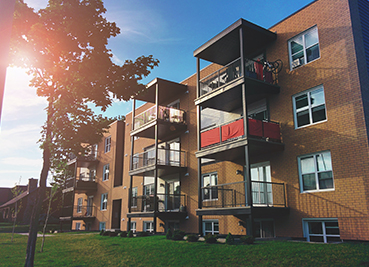
As seen in Denver Business Journal
As we move into 2024, there are numerous other storylines that will be worth following across the commercial and residential segments of the industry, as well, including a high-stakes lawsuit levied against the National Association of Realtors and major brokerages around commissions, what’s going to happen as some multifamily markets get saturated with supply, and the debate around how best to revitalize America’s downtowns.
Read on for five predictions about what’s coming in 2024 and a review of some of the big stories we covered in the past 12 months.
For even more insight into the year ahead, join us at The National Observer: Real Estate’s first-ever webinar on Jan. 25 at 2 p.m. ET. Real estate reporters from across the country will share their thoughts and predictions for the commercial and residential real estate industries in 2024. The webinar is free but exclusive to subscribers, so sign up today.
Prediction 1: CRE debt will take center stage as the financing market remains shaky
Commercial real estate loan maturities have been closely watched since the Covid-19 pandemic, when concerns arose that — because of government-imposed shutdowns and people changing their habits — properties would be at a bigger risk of foreclosure.
While we’re well out of the depths of the pandemic, there remains palpable concern about what happens to properties that’ve fallen out of favor with tenants in a financing market that’s largely still frozen. Commercial loans on the cusp of maturity will have a tough time refinancing.
By the numbers: In 2024, an estimated $182 billion is expected to mature among major commercial real estate property types, according to Moody’s Analytics Inc. Among that, an expected $47 billion is forecast to mature in the office loan world — the property type where the most distress is expected to be.
In fact, Moody’s found 68.6% of office commercial mortgage-backed securities loans examined were not paid off this year. It forecasts 76% of CMBS loans associated with office properties maturing next year are at a high risk of not being able to be refinanced.
Because there are so many questions about the fate of office towers across the country, tenants in the office market next year will have to exercise extra scrutiny in their lease negotiations. Meanwhile, new construction is locked up across the board but most especially for office buildings.
Although office gets a lot of attention, it’s not just those buildings that are facing financial challenges. Multifamily, long a darling of the commercial real estate world, also is going to face a critical test next year, especially projects and properties financed with floating-rate, short-term debt. That concern extends to multifamily construction loans.
Prediction 2: The housing market will loosen, but many 2023 patterns will remain
Expect a for-sale housing market next year that’s a little easier than this year’s was — but there won’t likely be a significant shift from current conditions.
Most housing economists and experts are forecasting a decline in mortgage rates next year — which will improve affordability somewhat. But inventory, one of the biggest levers of housing affordability, is still expected to be a challenge, although many are predicting existing-home listings and sales to be up next year and new construction to hit nearly 1 million starts, which will ease some of the inventory issues.
Key holdup: About two-thirds of current homeowners have a mortgage rate of 4% of less, creating what many have termed the mortgage lock-in effect. With mortgage rates much higher now, it’s become more expensive to purchase a home, prompting many current homeowners to stay in place.
Still, after new listings bottomed out in April at almost 35% below pre-pandemic norms, that shortfall had been reduced to 14% by November, according to Zillow Group Inc.
Mortgage predictions: Redfin Corp. anticipates the 30-year fixed-rate mortgage will fall to 6.6% by the end of the year, a prediction similar to that of the National Association of Realtors, which predicts an average mortgage rate of 6.3% in 2024. Realtor.com forecasts that next year’s rates will close around 6.5%, but most of 2024 is expected to see an average of 6.8%.
Market spotlight: In places like Phoenix, new-home sales continue to hold strong, bucking a national slowdown in activity. Phoenix is building a ton of new homes, with homebuilders there and elsewhere frequently offering concessions like mortgage-rate buydowns to make purchasing a home more enticing. But there are real questions about how long builders will be able to offer those types of incentives.
Prediction 3: Fed’s signal of cutting interest rates will unlock some CRE deal activity
Deal volume was largely frozen in 2023 across all asset classes, but some analysts are predicting a thaw may occur in 2024 — even if only slightly.
By the numbers: Investment volume was down 42% in 2023 from the prior year, according to CBRE Group Inc., which is predicting transactions to be down again in 2024 but by a more modest 5% year over year.
Two levers economists and investors are watching are what the Federal Reserve does with interest rates next year and the 10-year Treasury yield. But many are quick to note there remain a number of other factors weighing on deal activity, including pricing expectations between buyers and sellers.
Rebecca Rockey, deputy chief economist and global head of forecasting at Cushman & Wakefield plc, told me the Fed’s signal earlier this month to cut interest rates next year was anticipated, but there remains uncertainty about inflation, which means there is no guaranteed path for the federal funds rate.
“I think there is a temptation to place too much emphasis on the Fed pause and pivot,” Rockey said. “Certainly, it will add much needed clarity, but the fact remains that we are in the midst of a broader adjustment process to higher costs of capital, and that will persist well after the Fed’s pivot and throughout their cutting cycle.”
That being said, there’s a lot of capital on the sidelines eager to be put to work. That’ll likely increasingly go toward distressed deals in 2024.
When there’s a downturn, unique opportunities emerge, and we’ll likely see more examples of that in properties that trade next year. But much will hinge on the larger economy and financial markets, and a new normal with the interest-rate environment we’re in will start to be established.
Prediction 4: Cities will refine policies and strategies to reuse offices, revive downtowns
Return-to-office is happening but it’s still sluggish and inconsistent in many markets. There are plenty of headlines about crime and public safety, which — at minimum — alter perceptions about going into downtown areas. Public mass transit nationally hasn’t recovered to pre-pandemic ridership.
There’s a long-term story playing out across America on how to bring people, jobs and revenue back to downtowns. Elected officials and business executives alike are stepping up to devise new programs, incentives and strategies to bring people and business back to city centers.
Since the Covid-19 pandemic, many of these initiatives have been in pilot or trial mode. Next year, we’ll begin to see the more successful of these projects firm up — or new, perhaps loftier tactics take hold as revenue shortfalls from taxes and other revenue buckets start to hit city coffers. Already, assessors in places like Santa Clara County, California, are sounding the alarm about losses on the horizon.
No silver bullet: As I reported this summer, there’s no single answer that’ll resolve all of the difficulties facing downtowns — and every downtown has its own nuanced set of challenges. It might sound obvious, but experts stress that every initiative aimed at revitalizing a downtown should start with making downtown a place where people want to be.
Some cities like Milwaukee are looking at ways to diversify the types of people they bring to downtown — aka, making downtown not solely reliant on office workers.
Key strategy: A lot of cities are looking at ways to spur conversions, especially of underused office buildings into new uses like residential. But because these projects are complicated and expensive, many cities have introduced incentives programs to try and encourage those kinds of projects. The White House has even unrolled guidance around how to leverage federal programs for such projects. The question is, will they be enough to drive these deals to success?
Prediction 5: Apartment sector will slow, rents will soften in high-supply markets
The for-rent sector is ending 2023 with signs of slowing, with an overall market that’s less competitive than it has been as a record amount of apartments and rental units deliver, especially in high-growth Sun Belt markets.
That slowdown is expected to continue into 2024. More than 461,000 units are scheduled to complete by the end of this year, and that number likely will be topped next year, with an estimated 670,000 units expected to deliver in 2024, according to RealPage Inc. For some metro areas, that’ll mean less rent growth and, perhaps, even cuts.
Rental-rate cuts: Markets that saw the deepest year-over-year rent cuts this year, as tracked by RealPage and as of November, were Cape Coral-Fort Myers, Florida (-6%); Austin-Round Rock, Texas (-5.9%); and North Port-Sarasota-Bradenton, Florida (-5.4%). Those are all markets that’ve added more than 20% of their apartment inventory in the past five years.
“It’s going to be tough in this environment where there’s so many lease-ups … competing for the same renter pool, which I think will suggest longer lease-up periods and probably rents that are below target,” Jay Parsons, senior vice president and chief economist at RealPage, recently told me. “That’s going to certainly put pressure on developers who are in very high-supplied submarkets, in particular.”
This past year saw an all-time high of nearly 11,500 new units added to the Nashville, Tennessee, apartment market, leading to that city’s highest multifamily vacancy rate in 20 years. Supply gains like that in Music City and other Sun Belt metros create the prospect of rent cuts, while in more-modest-growth cities like Minneapolis, rent growth could continue but likely at a more modest rate as more construction delivers.




